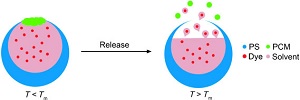 |
| A microbottle releases dye (or drugs) when its "cork" dissolves in heat.--Courtesy of Wiley-VCH |
Researchers from the U.S. and South Korea have developed an intelligent delivery system using a structure much like a corked bottle that releases a drug payload when triggered by a rise in temperature.
The concept is relatively simple: The scientists at the Georgia Institute of Technology, Emory University in Atlanta and Yonsei University in Seoul designed "microbottles" with "corks" which, at a defined temperature, dissolve to release the contents of the bottle. The bottle part of the microscopic structure is made of polystyrene, and by loading the polymer sphere with toluene, which evaporates through the top making a small hole, the final structure has a bowl shape. This can easily be loaded with drugs, according to a report from nanowerk.
Then, to hold the drug inside the capsule until its triggered release, the team used a combination of materials--the ratio of which affects the melting point--as the "cork." By changing the ratio of tetradecanol and lauric acid used to make the cork, the cork could be targeted to undergo a phase-change and dissolve at a particular level. And until that point, the whole capsule would be sealed shut with the drug inside.
Heat is a useful trigger for certain drugs, according to the report, because of the temperature-altering nature of some diseases. Stress and inflammation are indicators that would allow the release of a drug at diseased parts of the body. Also, cancerous cells may be locally heated before treatment with encapsulated chemotherapy, which would be released upon entering the tumor, protecting healthy cells in the process.
The team published the study in the journal Angewandte Chemie.
- here's the nanowerk report
- and here's the abstract